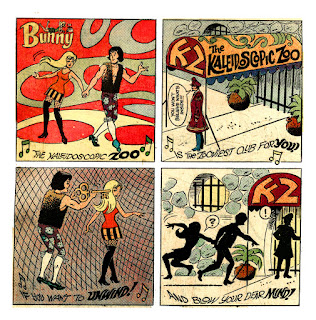TRULY GONE & FORGOTTEN : BUNNY
 |
| Meet the hip boss, same as the mod boss. |
Like Gilgamesh of ancient myth, Bunny Ball - star of her self-titled teen humor and fashion comic from Harvey Comics in the 1960s - sprung from the loins of three parents, more or less.
Her most obvious and only direct progenitor was Archie Comics, the 500-pound gorilla of teen humor comics since its debut way back in 1940. However, where Archie and his gang took enormous pains to stay relatively agnostic to their era -- a perfect Archie story was no more explicitly set in any one decade than another, a few adjustments for fashion nor technology notwithstanding -- Bunny and her pals were almost painfully contemporary. Or, at the very least, they pretended to be.
The faux psychedelia of Bunny's world came as fast and without apology as it came under-researched and spontaneous. Ostensibly capturing the vibe of hippie culture, it bore the mark of middle-aged men doing their damnedest to replicate slang, music, fashion and fads which only impressed itself upon their minds in passing, and with the often-contemptuous distance of the generation gap.
 |
| A Clockwork Orange (1971) |
The names of Bunny's creators weren't particularly well-recorded, but it's not impossible that Simon, directly or otherwise, had some influence on the voice and style of Bunny's world. He'd always exhibited some fascination - and a little sympathy - with the then-youthful Baby Boomer community, so even though he'd never directly worked on Bunny as far as we know, there's a good chance he midwifed some of its conceits.
And "conceits" is a perfect word. Bunny began life as indistinctly defined among the herd of unfortunate teen comedy stars as anyone else, with a leaning towards fan-designed fashion as Katy Keene or Betty and Veronica. The affectations of flower power culture defined the book for the most part, though, with increasingly trippy cover designs and hip doggerel introducing the stories in lieu of splash pages. The dialogue inside concentrated on "happenings" and "scenes," everything was "go-go" and a "turn-on" and what I'm trying to avoid saying outright is that this is the way your grandparents spoke when they were fucking.
This kind of constant pursuit of the zeitgeist puts a real strain on the middle-aged men who are asked to produce it, which is probably why Bunny started to falter and sputtered out with a staggered final two issues which would make Alan Moore's last 1963 and next Big Numbers look like a weekly by comparison.
If the book started to dip in energy and enthusiasm, though, it's possibly because its last living precedent also sputtered out. Much like ROM, Team America, US1, Crystar and other toy-inspired comics, Bunny is believed to have been originally intended as a tie-in to a hip, swinging new fashion doll -- of the Barbie variety -- but which petered out after a short shelf life (In Bunny's case, that shelf-life was ... non-existant). Producing a lot more story than the toy ever produced happy children, at least Bunny was a relative success, even if it was a weird artifact of a bygone era.
 |
| I forgot to mention that the fashion pages, for some reason, included an airplane banana. |

Comments
Pretty sure Trina had nothing to do with these. She was still doing undergrounds then.
Many issues had other characters in backup stories, like the shapeshifting grocer Fruitman (wouldn't surprise me if the plane is a nod to him) and Sooper Hippie.
http://learning2share.blogspot.com/2008/01/shes-bunny-queen-of-in-crowd-late-1960s.html
D.D.Degg
D.D.Degg